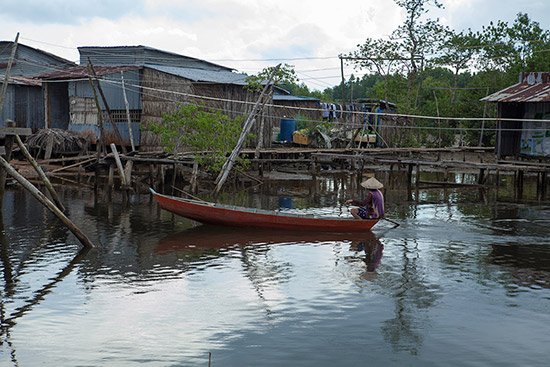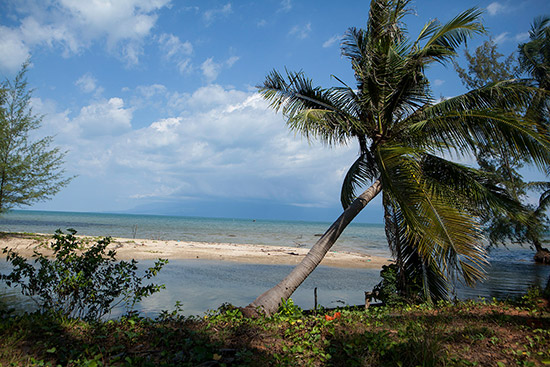Phu quoc national park: Cua Can River, Duong Dong River
Phu Quoc National Park is rich with life, both animal and plant life. The boundaries of the park stretches from Cua Can Village in the west up to Ganh Dau Village in the north west
resort phu quocPhu Quoc National Park.
The Phu Quoc National Park was established in 2001 and it is located in the north covering 70% (31,422 hectares) of the island area. The boundaries of the park stretches from Cua Can Village in the west up to Ganh Dau Village in the north west, then to Thom Village in the north east, and finally to Ham Ninh Village in the east.
Topography & Hydrology
The park is mainly covered with three mountain systems found on the island: the Ham Ninh, Ham Rong, and Ganh Dau mountain range. The two main river systems that cut across the park are the Cua Can River and the Duong Dong River. The smaller Rach Tram River in the north also cuts through the park. All three of these rivers provide access points, via boat or kayak, inside Phu Quoc National Park.

The park also includes 60kms of coastline within the park boundaries and includes the following beaches: Cua Can Beach, Vung Bau Beach, Thom Beach, Rach Vem Beach, Rach Tram Beach, Ham Ninh Beach and Dai Beach. All of these beaches have been slated to be developed further for tourism.
Biodiversity
Phu Quoc National Park is rich with life, both animal (fauna) and plant (flora) life. Some of the plants found in the park are also used for medicinal purposes.

Animals that can be found in the park include: silvered langur, hornbill, sea eagle, woodpeckers, brown hawk owl, slow loris, civet cat, wild pig, crab-eating macaque, python, stump-tailed macaque, small-clawed otter, giant flying fox bat, fruit bats, and more.

The overall biodiversity numbers are as follows:
1164 plant species
61 mammal species
134 bird species
47 reptile species
23 amphibian species
Where to spot wildlife
As most National Park trails are not developed or off limits, most of the wildlife you will see will be next to a dirt road that looks like:
1) On K7 Road between Rach Tram Beach & Thom Village
K7 Road is the road that takes you to Rach Tram Village and cuts through a pristine section of the National Park. Wildlife can be spotted next to the road that cuts through Ham Rong Mountain.

Some of the animals you may spot here are:
Mammals: Eurasian wild pig (Heo rung), Sambar (Nai), Flying Fox Bat (just before sunset), Long tailed macaque (Khi
duoi dai), Otter (Close to Rach Tram River), Yellow-Throated Marten (Chồn), Phu Quoc Red squirrel (Soc do Phuquoc), Northern Treeshrew (Doi), and others.
Birds: Goose, Swallow, Teal, Great hornbill, Egret, Pelican, Magpie-robin, etc
Reptiles: Snake, Python, Crocodile (not likely but have there is one in captivity at Rach Tram Village), Turtle (Near Rach Tram River), Gekko gekko, etc.
Amphibians: Toad (Coc), Frog (Ech), Tree-frog (Nhai), etc
Note: If you go to Rach Tram Village, the Rach Tram River is teeming with mangrove specific wildlife such as otters, river turtles, etc. The Rach Tram river also cuts deep into the Phu Quoc National Park. For 200,000VND to 300,000VND a local fisherman will take you down the river.
2) Ham Ninh Mountain Range
At a side road near Ham Ninh Village and at the foot of the Ham Ninh Mountain Range lies a great spot to observe wildlife. Wildlife here is harder to spot however if you come here before sunrise you may see macaques and the silver langur. The road here is not named and the terrain is a quite rough and can be difficult to navigate during the wet season.

Some of the animals you may spot here include:
Mammals: Slow loris (Cu li lon) – can be viewed in the evenings, Pygmy loris (Cu li nho), Long tailed macaque (Khi duoi dai), Indochinese silvered langur (Vo ọc bac), Otter, Phu Quoc Red squirrel (Soc do Phu quoc), Eurasian wild pig (Heorung), Yellow-Throat ed Marten (Zhồn), Sambar (Nai), Northern Treeshrew (Doi), etc.
Birds: Brown Hawk Owl (Cú), Spotted-necked Dove (cu), Flowerpecker (Sau), Forest Wagtail (Chia voi), Woodpecker (Go kien), Lesser Coucal (Bim bip), Red Jungle-Fowl (ga rung), etc.
Reptiles: Varan (ky da), Snake (ran), Tortoise (Rua), Gekko (Tac ke), etc.
Amphibians: Toad (Coc), Frog (Ech), Tree-frog (Nhai), etc.
3) Near the forest trail – Suoi Cai Road
The red dirt road from Ganh Dau to Thom Village known as Suoi Cai Road is a great place to spot the silver langur.

4) Quoc Phong Road
Quong Phong Road is a hotspot for wildlife spotting and you have the best chance of larger mammals here than anywhere else. The road is rough however the access point is easier to find as it is off Nguyen Trung Truc Road, the road that takes you to Thom Village from Duong Dong Town.

Some of the animals you may spot here are:
Mammals: Eurasian wild pig (Heo rung), Sambar (Nai), Flying Fox Bat (just before sunset), Long tailed macaque (Khi
duoi dai), Otter (Close to Rach Tram River), Yellow-Throated Marten (Chồn), Phu Quoc Red squirrel (Soc do Phuquoc), Northern Treeshrew (Doi), and others.
Birds: Goose, Swallow, Teal, Great hornbill, Egret, Pelican, Magpie-robin, etc
Reptiles: Snake, Python, Crocodile (not likely but have there is one in captivity at Rach Tram Village), Turtle (Near Rach Tram River), Gekko gekko, etc.
Amphibians: Toad (Coc), Frog (Ech), Tree-frog (Nhai), etc
Finally, 7,200 hectares of the park consists of the coastal area where you will find 9 species of seagrass, a key food source for the rare and elusive sea dugong.

How to get here
It is pretty easy to get to Phu Quoc National Park since 70% of the island is considered a “National Park”, you just have to head north or east. The total road system that cuts through the park is about 90kms in length with a total of 12 bridges. The most scenic areas are by Thom Village and Ham Ninh Village.
What to see
View wildlife – The best time to view the larger animals is before sunrise (monkeys), sunset (flying fox bat), and at night (nocturnal cats and owls). We have seen silver langurs near the forest walk at 10am, macaques near Ham Ninh at 6am, and a hornbill near Thom Village at 11am. The chance of you seeing these animals are quite rare, but not impossible. We advise that you bring your binoculars if you want to see the numerous bird species found on the island.
Observe the flora – The forests at the park are inundated with a variety of flora including flowers such as wild orchids, ferns, medicinal plants such as wild ginseng, colorful mushrooms some of which are edible (e.g. the tram mushroom), mosses, lichens, and a variety of trees. Remember to take only pictures and only leave behind footprints.

See Mount Chua – A 20 minute drive from Duong Dong Town lays Mount Chua. At 603 meters in height, Mount Chua is the National Parks and Phu Quoc’s highest mountain and is connected to the Ham Ninh chain of mountains that stretch for 30kms along north eastern Phu Quoc. Currently you can only see Mount Chua as this mountain is not accessible by the general public however there are plans on transforming Mount Chua into a tourist spot by building a trail to the top and a viewing platform complete with a snack bar and restaurant. It is still possible to trek to the top of Mount Chua however you will need to hire a private tour guide. Contact one of the tour agencies on the island and they will find someone who will take you up the mountain. The panoramic views at the top are breathtaking, so we’ve heard.
What to do
Motorbike from Duong Dong Town to Thom Village – You can rent a motorbike from Duong Dong Town and explore the northerly parts of the island on your own. The best area to see the mountainous peaks and dense vegetation can be found on the road toward Thom Village (Bai Thom). To get there from Duong Dong Town, go down Hung Voung Road and cross the bridge, and then head north towards Thom Village.
Hiking and trekking – There are some unmarked trails just south of Thom Village that you can explore. Just park your motorbike or bicycle at the side of the road and explore the trail.
Boat – You can hire a boat and enter the park through the three river systems listed above. Organized tours will take you into the park via the Cua Can River.
Forest walk – 5kms east of Ganh Dau Village there is a nice trail that takes you inside a heavily forested area. You can navigate the trail by either on foot, motorbike, or mountain bike. The trail here is mostly flat however it can get quite muddy after it rains. The trail’s entrance is marked by a large sign and there is a small unguarded parking area if you wish to park your motorbike. The road to get here from Ganh Dau Village is currently an unpaved red dirt road but it is easy to find. In Ganh Dau Village, look for the Petrolimex gas station or ask someone where the petrol station is as the gas station is located on the road that will take you to the trail.














